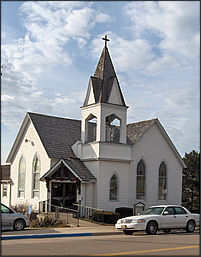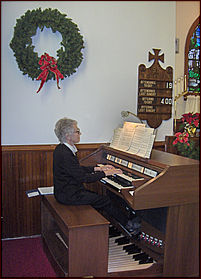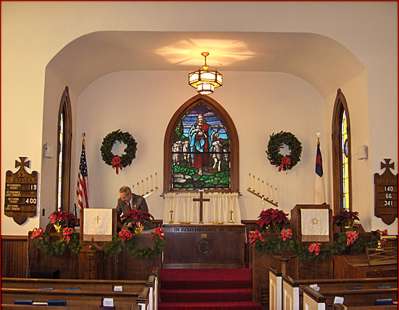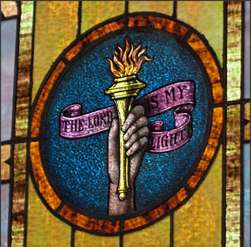In
Mr. Hunter's previous sermon--Hard or Soft? (PDF)-- he discussed a dichotomy facing the contemporary church between
hard faith and
soft faith:
Within the context of the Church, Hard Faith people place an emphasis on the obligations of the religious life, the demands of discipleship, and the need for moral clarity. They prefer those passages in the Bible that are clear in defining what is right and what is wrong to help them achieve righteous living. If your faith is hard, you’re focused on knowing God’s truth, keeping the Ten Commandments, and living a disciplined life.
The Soft Faith people are more likely to view religion as a relationship of grace. They tend to stress God’s love for the oppressed and view righteousness as fulfilling our Lord’s call to heal the sick, liberate the prisoner, and offer a cup of water to the least of God’s children. If your faith is soft, you are more likely to focus on keeping the command of Jesus to love God and neighbor, than religious rules written long ago. For Soft Faith people living a life of love and acceptance is the key to righteousness and scriptures that would limit their ability to extend God’s love and grace to the marginalized are subject to reinterpretation.
To be vital, he explained, "we [must] keep our hard faith and soft faith in a tension that is guided by the Holy Spirit."
On Sunday, 30 January 2005, Mr. Hunter continued this line of thought by focusing upon the
hard demands of Jesus. The hard teachings of Christ are that we must control our actions, attitudes, thoughts, intents, feelings--all aspects of our lives--if we are to meet the original intent of God's law, the law which Jesus came to fulfill. Today's Gospel reading illustrates Christ's hard demand:
If your right eye causes you to sin, pluck it out and throw it away; it is better that you lose one of your members than that your whole body be thrown into hell. And if your right hand causes you to sin, cut it off and throw it away; it is better that you lose one of your members than that your whole body go into hell. (Matthew 5:29-30 RSV)
Reformed commentators since John Calvin have agreed that Christ does not mean us to hack away at our bodies. Christ's lesson is figurative, showing us the extremes to which we must go to avoid sin. Who among us, Mr. Hunter asked, would not accept the extreme measure of sacrificing a limb, tissue, or an organ in order to live? One man he knew, for instance, agreed to the amputation of his cancerous right arm in order to save his life--a decision he did not regret.
Jesus's hard demands warn us of
spiritual cancers which would threaten our relationship with God, but often these cancers are not immediately apparent to us. These threats include anything which we set up as a false god: drugs, alcohol, gluttony, sex, gossip, and so on.
Recognizing the danger these threats present to our spiritual life is only half the problem; the other half is to act upon our knowledge. God will help us if we have
the courage to cut.




 On 02 January 2005--Epiphany Sunday--I visited my childhood church of Murray Presbyterian Church in Murray, Nebraska. The church has existed since 1860 and six generations of my family have worshiped there, so the building you see to the left is naturally dear to my heart. As many of you know, no building is more comfortable to walk into than the place where you were baptized, hissed at during the sermons to be quiet, taught about parables in Sunday School, progressed from a squirming angel to the Virgin Mary through years of Christmas pageants, joined the church, taught Bible School, and were married. I guess its because the people there who still know you have no illusions about you but love you anyway, which isn't a bad way to think about our life in the church in general.
On 02 January 2005--Epiphany Sunday--I visited my childhood church of Murray Presbyterian Church in Murray, Nebraska. The church has existed since 1860 and six generations of my family have worshiped there, so the building you see to the left is naturally dear to my heart. As many of you know, no building is more comfortable to walk into than the place where you were baptized, hissed at during the sermons to be quiet, taught about parables in Sunday School, progressed from a squirming angel to the Virgin Mary through years of Christmas pageants, joined the church, taught Bible School, and were married. I guess its because the people there who still know you have no illusions about you but love you anyway, which isn't a bad way to think about our life in the church in general.
 My mother, Virginia Spangler, has been organist at the church for over 40 years. During that time, she's gotten smaller but her electric organ has gotten bigger (with bigger speakers) so she still celebrates worship with music each Sunday. She told me she always likes to play French carols as the prelude on Epiphany Sundays and that's what she's doing in the picture at right.
My mother, Virginia Spangler, has been organist at the church for over 40 years. During that time, she's gotten smaller but her electric organ has gotten bigger (with bigger speakers) so she still celebrates worship with music each Sunday. She told me she always likes to play French carols as the prelude on Epiphany Sundays and that's what she's doing in the picture at right.

 On this Sunday--Epiphany Sunday--Rev. Martin C. McDaniel linked the star the Magi followed to the hopeful light of Epiphany. The magi worshiped Christ because they recognized his divinity as the light and hope of the world. So the window with the medallion that says "The Lord is my light" seems most appropriate for pondering. Faith in Jesus, Mr. McDaniel said, gives us the strength to persevere in the face of current problems, whatever they may be.
On this Sunday--Epiphany Sunday--Rev. Martin C. McDaniel linked the star the Magi followed to the hopeful light of Epiphany. The magi worshiped Christ because they recognized his divinity as the light and hope of the world. So the window with the medallion that says "The Lord is my light" seems most appropriate for pondering. Faith in Jesus, Mr. McDaniel said, gives us the strength to persevere in the face of current problems, whatever they may be.
